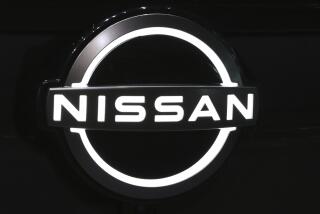Groups to Seek Safety Data on Air Bags
- Share via
DETROIT — Amid growing controversy over the potential hazards of air bags, five consumer groups are expected to ask federal regulators today to force the auto industry to disclose detailed safety information about the air bags in every car and truck model.
The groups contend that consumers are entitled to basic information such as the crash speed that triggers the air bag, the distance the bag travels, the speed at which it deploys and the angle of release--all of which vary among car models.
In their 22-page petition, the consumer groups allege that auto makers and regulators have long been aware that different air bag designs provide different degrees of protection and risk. Manufacturers often opt for cheaper, rather than the most effective, systems, the groups charge.
Auto makers strongly denied the allegation and said that the consumer groups are closely aligned with trial lawyers suing the companies for safety defects.
“Cost is never our prime consideration when designing a safety system,” said Michael Aberlich, a spokesman for Chrysler Corp.
The petition to the National Highway Traffic Safety Administration comes just a month after the agency began allowing certain at-risk individuals to install air bag cutoff switches in their vehicles.
Air bags have killed 91 people, including 51 children, since 1990. Most of the fatalities involved unbelted occupants in low-speed crashes that normally would cause little damage or injury.
The groups--the Center for Auto Safety, Public Citizen, Parents for Safer Air Bags, Consumer Federation of America and the American Academy of Pediatrics--say that consumers now have insufficient data to make decisions about the safety of air bags or whether to opt for cutoff switches in their vehicles.
“Some air bags are better than others,” said Clarence Ditlow, president of the Center for Auto Safety. “The American public ought to have this information.”
NHTSA spokesman Phil Frame said that air bag systems vary but the differences are not significant, and there is insufficient data to determine if one air bag system is safer than another. Federal regulators had not seen the petition Wednesday. They have four months to respond.
Citing government records, the consumer groups said that a majority of manufacturers have reported no driver air bag deaths, and eight auto makers--all foreign makers--have experienced no passenger air bag deaths.
The petition said the wide differences in air bag performance is illustrated in a 1992 NHTSA study of nine 1990 vehicle models. It noted that the peak velocity of deployment varied from 98 to 211 mph, the velocity at the time of face contact ranged from 39 to 184 mph, and the time to full inflation varied from 21 milliseconds to 47 milliseconds. It also noted that performance varied by the way bags are folded.
Robert Sanders, president of Parents for Safer Air Bags, said that several children have been killed by air bags in accidents in which the vehicle was traveling 5 mph.
“These deaths are distressing,” said Sanders. “This is important information for consumers to have.”
Sanders’ 7-year-old daughter was killed by an air bag that deployed in a low-speed crash in a minivan. He is suing Chrysler.
The petition notes that Mercedes-Benz uses a “dual threshold” system that deploys at different speeds depending on whether the occupants are using seat belts or not. If the riders are belted, the air bag is released in a crash impact of 18 mph; for unbelted occupants, deployment comes at 12 mph.
The consumer groups also say “dual level” inflation systems can minimize the aggressiveness of deployment. Such systems allow for more gentle deployment in lower-speed crashes and more forceful deployment at speeds greater than 18 mph. GM used such a system in the 1970s but has not used it since.
The petition alleges that Chrysler was offered such a system by Allied Signal in 1993 but rejected it as not cost-effective. Chrysler denies that cost was the reason.
Auto makers say that some additional information about air bags may be useful to consumers, but they are concerned that it could be confusing or misleading. They argue that air bags are safe in almost all cases if occupants use their seat belts and children are placed in the back seat.
Barry Felrice, director of regulatory affairs for the American Automobile Manufacturers Assn., the lobbying arm of the Big Three, said the petition shows a lack of technical understanding of air bags and vehicle design.
He said that air bags are designed as part of a total vehicle safety and structural system. An air bag system cannot be compared with another without understanding the total design of the vehicle in which it is installed.
“You can’t rate air bags by selected characteristics,” Felrice said.
For instance, he said a fast deployment might be proper for a small vehicle with a stiff frame that would not absorb much energy in a crash, whereas a slow deployment might be best for a larger vehicle with a big engine compartment.






